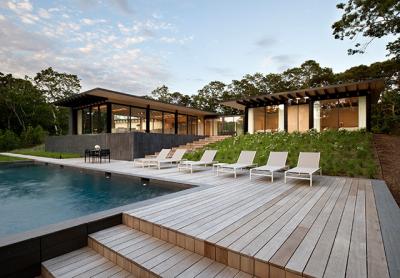Design at Promised Land: Wind Was the Key

When Paul Masi and his colleagues at Bates Masi and Architects in Sag Harbor design a house, they focus first on its key elements. “We try to understand what the essence of it is,” Mr. Masi said. “We know that it’s going to be a pretty house, but it needs to be more than that. It needs to be meaningful to the occupants and also in its relationship to the landscape.”
For this house of more than 4,000 square-feet in Promised Land, Amagansett, the key element turned out to be the wind.
The owners — a married couple with two children — are kite boarders, windsurfers, and sailing enthusiasts. “That was something that made me think, ‘Okay, how can this house be a part of why they are here?’ ” recalled Mr. Masi, who had originally met his clients by happenstance in the early 2000s when they spotted him in the midst of physically building his own house. “I had my tool belt on, they walked in the house and said, ‘Wow, this is amazing, do you know who the architect is?’ ”
Nearly 20 years later, Mr. Masi ushered the couple into a striking home of their own: an H-shaped structure with bedrooms on one side, an open kitchen and living/dining area on the other, and an all-glass walkway connecting them. Sliding glass doors throughout make for seamless indoor-outdoor living.
During the design process, Mr. Masi let his clients’ favorite pastimes inspire him. “If you’re a kiteboarder or if you surf or do any of those sports, you’re really in tune with what’s happening with the weather — the direction of the wind, the speed of the wind, what the tides are,” Mr. Masi said. He immediately ordered weather data for the property. As it turned out, the wind largely emanated from the west, so Mr. Masi designed the house on an east-west axis. This positioning allows the breeze to interact with the structure, he said, providing its residents with tactile, visual, and even olfactory awareness of its presence.
Vents were placed in the ceiling beams to provide air flow. A thin-profile roof was designed with large overhangs, to trap the wind and direct it through the vents. “It’s the same concept as an umbrella — you know, how when you open an umbrella it really captures the wind.” Mr. Masi explained.
A reflecting pool was put in adjacent to the glass walkway. “Water is such a good medium to register the wind,” Mr. Masi said. A quick glance would tell the residents just how windy it was: “If there’s no wind, the reflecting pool is just a sheet of glass.” Aromatic plants such as lavender and mint were placed on the windward side of the property, so that when the house’s doors are open and the breeze kicks up, the space is redolent with their scents.
The house does not feature exotic materials from far-flung places. “Most everything is made of natural materials,” Mr. Masi said. “We were looking to use materials that were readily available and that weren’t intensive on the environment —you know, shipping it from God knows where. They are very commonplace materials, but we were creative with them to give the house its own unique character.”
The predominance of glass in the house, which is nestled between bushes on a narrow clearing, allows panoramic views of shrubbery, grass, and sky “As you travel through the house,” he said, “you are never looking at a wall, you’re looking at a window that’s connecting you to the landscape. You’re always sort of walking towards the outdoors. And when the doors are all open, it feels like you’re in a pavilion and really immersed in nature.”
